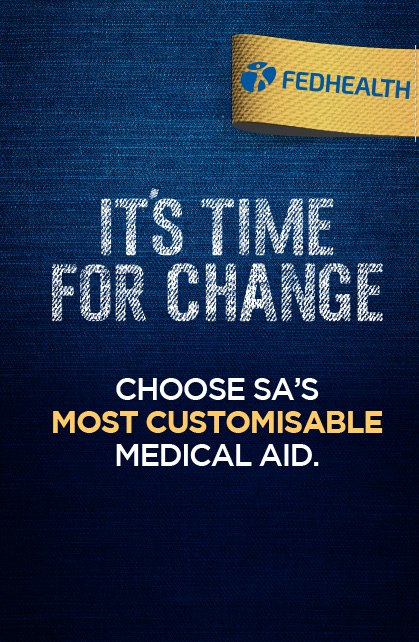Four ways medical aid is getting a shake up
When it comes to medical aid in South Africa, you may think you have a lot of choice as far as the type of cover and plan you’re on is concerned – whether it’s a basic hospital plan or a comprehensive family option. But the truth is, when it comes to the actual structure of a medical aid plan, you don’t have as much choice as you think.
With this in mind, Fedhealth has shaken things up, by offering unrivalled levels of customisation that affect every part of your cover – from risk to day-to-day savings and optional discounts. After all, the more customisation you have available, the more you can control the cost and quality of your cover as well as your medical aid expenses. So what are the problems with regards to customising medial aid – and what solutions is Fedhealth offering?
- The problem: Hospital plans aren’t backed up with day-to-day savings.
Your day-to-day savings is the portion of money you can access each year as part of your medical aid plan to cover general medical expenses such as visiting the dentist or buying flu medication. If you’re on a hospital plan because you have no current health issues, you will have no day-to-day savings at all. That may work well for now, but what if you hurt your back and need regular physiotherapy? Or what if you need reading glasses? In these cases, you may want to upgrade to a more comprehensive plan with day-to-day savings to help cover the unforeseen costs. The problem is, you’ll usually have to wait until the following year to upgrade – which doesn’t help if you’ve got medical bills to pay now.
The solution: Fedhealth’s hospital plans have a back-up facility for unforeseen day-to-day expenses. At Fedhealth you can activate your flexible savings should you suddenly find yourself in need of day-to-day savings, and you will only pay for the amount that you have activated over 12 months, interest free. You can also upgrade any time of the year to a higher option – you don’t just need to wait for a specific time to do so.
- The problem: Day-to-day savings is inflexible.
Day-to-day savings is typically around 25% of your monthly medical contribution, and most medical aids give you very little say in how they’re structured and how you pay for them. Whether you need more savings than what you’re allocated – or less – there’s no choice in the matter. And if you don’t use all your savings in a given year, you’re still paying for this facility via your monthly contribution.

IT’S TIME FOR CHANGE
The solution: Fedhealth offers a flexible savings plan where you have a “line of credit” available to use for day-to-day savings. But until you start using it, you don’t pay for it – which puts you in total control. If and when you then use your day-to-day savings, you’ll only pay for the amount you use, and that repayment is made over 12 interest-free months. Like a credit card, you repay only what you spend: it’s not a fixed amount you’re forced to pay for whether you want it or not.
- The problem: Network hospital options offer limited benefits.
Network-only medical aid plans usually cost less, because you’re restricted to only using certain hospitals that are contracted to the medical scheme to which you belong. While being restricted to certain hospitals may sound fair in return for a lower medical aid contribution each month, most network-only options also have reduced benefits. But if you’re saving the scheme money by being restricted to using only network hospitals, isn’t it unfair to cut your benefits too?
The solution: When it comes to network hospitals, Fedhealth’s GRID options cost 10% less than the non-network equivalent, but you still get exactly the same benefits with absolutely no difference in the quality.
- The problem: You may not claim as much as others – but you still pay the same.
Medical schemes work by pooling all their member contributions and then using this money to pay for a claim a member makes. But if you’re healthy and don’t claim often, why does your medical aid still cost the same as an elderly member who may need expensive hospital procedures such as hip and knee replacements? Logically, you should be paying less if you’re claiming less, but unfortunately, that’s not the case.
The solution: Fedhealth’s Elect options give you the same benefits as the main variant, but you pay 25% less for your monthly contribution. All emergency procedures are still covered in full at any hospital of your choice but if you need a planned hospital procedure, which is unlikely if you’re young and healthy, you then pay a fixed excess amount for every procedure – just like the excess you’d pay on a car insurance claim.
South Africa’s medical aid industry has been long overdue for change in terms of the flexibility it offers. While some areas of medical aid can’t be changed due to regulations, there are others that can. By thinking out of the box, Fedhealth is turning these problems into opportunities and adding more value than ever to the average South African medical aid consumer.

